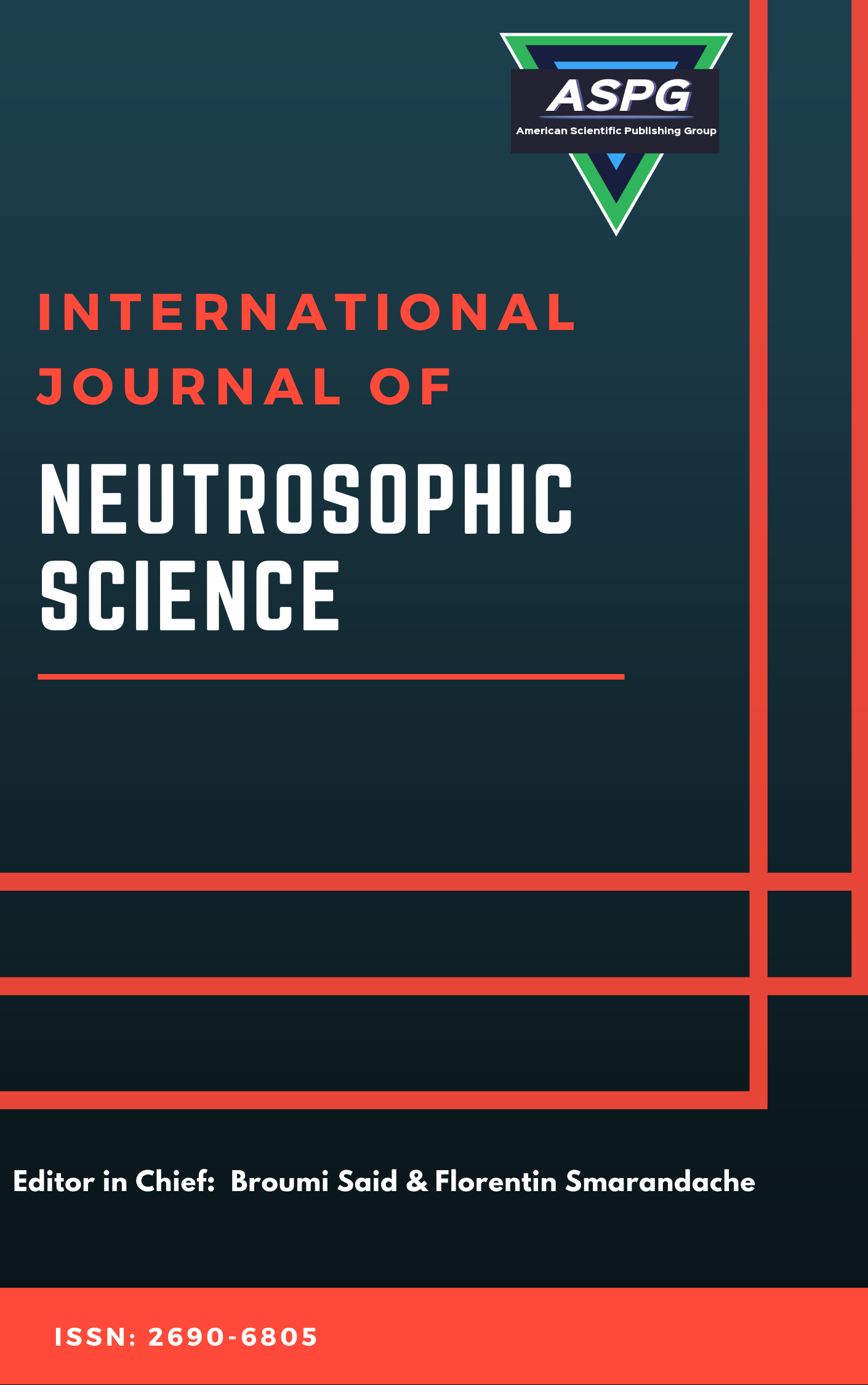

Volume 27 , Issue 1 , PP: 176-192, 2026 | Cite this article as | XML | Html | PDF | Full Length Article
Remya P. George 1 , Nazia Ahmad 2 , Rubina Liyakat Khan 3 , Sajithunisa Hussain 4 , Samandarboy Sulaymanov 5 , Ambuj Kumar Agarwal 6 *
Doi: https://doi.org/10.54216/IJNS.270117
A vast amount of Internet of Things (IoT) devices deployment has created huge issues about trust management and reliability guarantees in heterogeneous, dynamic and often uncertain ecosystems. Available probabilistic or fuzzy-logic-based models do not hold water to deal with indeterminacy and contending data in distributed IoT networks. The current paper proposes a brand new framework to model trust and reliability in IoT systems by implementing Neutrosophic Logic to build quantification and strengthen trust and reliability in IoT systems. Incorporating the semantic understanding of data and node behavior in uncertainty using three dissimilar elements to represent trust: truth, indeterminacy and falsity, the model commands a wider range of semantics in the relationship of data and nodes during the phase of uncertainty. A mathematical solution is established to measure trust scores and reliability indexes based on Neutrosophic membership functions. Further, a new dynamic trust assessment and anomaly detection algorithm is presented based on a multi-layered decision-making process. This simulation and case- study definition shows the effectiveness of the proposed framework in having less false positives, better reliability estimation, and the solid optimization of decision support in a very uncertain environment of IoT. The work therefore further develops the process of Neutrosophic systems integration with IoT and its setting up of basis of more intelligent, context-aware and robust trust management systems.
Neutrosophic Logic , internet of things (IoT) , Trust management , Reliability modeling , Indeterminacy , Uncertainty quantification , Mathematical modeling , Decision support systems
[1] M. Eid, O. Astanakulov, O. Khayitov, K. Rakhmanov, and S. Mirzaliev, “AI-Driven Strategies for Enhancing User Experience in Virtual Tourism,” Journal of Business Research, vol. 129, no. , pp. 456–465, 2021. DOI: 10.1016/j.jbusres.2021.02.054
[2] A. Zaid, N. Zikrillaeva, and G. Gulyamova, “Mitigating Cybersecurity Threats in Smart Cities: A Com- prehensive Framework,”Computers Security, vol. 109, no. , pp. 102–113, 2022. DOI: 10.1016/j. cose.2021.102113
[3] A. Bettayeb and M. Eid, “Exploring the Impact of Artificial Intelligence on Employee Performance: A Case Study,” Journal of Business Research, vol. 128, no. , pp. 123–132, 2021. DOI: 10.1016/j. jbusres.2021.01.045
[4] B. A. Abdelfattah, S. M. Darwish, and S. M. Elkaffas, “Enhancing the Prediction of Stock Market Movement Using Neutrosophic-Logic-Based Sentiment Analysis,” Journal of Theoretical and Applied Electronic Commerce Research, vol. 19, no. 1, 2024. DOI: https://doi.org/10.3390/ jtaer19010007
[5] N. M. Alnaqbi and W. Fouda, “The Impact of AI Tools on Learning Outcomes: A Study of Higher Education Institutions,” Education and Information Technologies, vol. 27, no. 5, pp. 6437–6450, 2022. DOI: 10.1007/s10639-022-10804-3
[6] T. Baig, D. Ather, S. Setia, S. J. Quraishi, and S. M. Mian, “Towards Advanced Animal Care: A Li-Fi and IoT-Based System for Monitoring Newborn Livestock,” ES Materials & Manufacturing, vol. 23, pp. 1038, 2023. DOI: http://dx.doi.org/10.30919/esmm1038
[7] K. Bedair, N. Omer, A. A. H. Abdellatif, K. S. Nisar, S. R. Munjam, and A. I. Taloba, “AI-Driven Approaches for Predictive Maintenance in Manufacturing: A Review,”Journal of Manufacturing Systems, vol. 5822, no. , pp. 100–110, 2022. DOI: 10.1016/j.jmsy.2022.01.005
[8] R. Kumar, R. L. Khan, R. Singh, A. Singh, R. Vijay, and D. Ather, “Development and Evaluation of an IoT-Based Gas Leakage Detection System Using Arduino Uno,” in Proc. Int. Conf. on Cyber Intelligence and Information Retrieval, 2023, pp. 307–319.
[9] F. Smarandache, “New Types of Neutrosophic Set/Logic/Probability, Neutrosophic Over-/Under-/Off- Set, Neutrosophic Refined Set, and their Extension to Plithogenic Set/Logic/Probability, with Applications,” 2020. DOI: https://doi.org/10.3390/books978-3-03921-939-1
[10] S. Topal, F. Tas, S. Broumi, and O. A. Kirecci, “Smart Agriculture: IoT Applications and Challenges,” Computers and Electronics in Agriculture, vol. 175, no. , pp. 105–115, 2020. DOI: 10.1016/j. compag.2020.105115
[11] D. K. Kadali, R. N. V. Jagan Mohan, and M. C. Naik, “Enhancing Crime Cluster Reliability Using Neutrosophic Logic and a Three-Stage Model,” Journal of Engineering Science and Technology Review, vol. 16, no. 4, 2023. DOI: https://doi.org/10.25103/jestr.164.05
[12] U. Rivieccio, “Neutrosophic Logics: Prospects and Problems,” Fuzzy Sets and Systems, vol. 159, no. 14, pp. 1860–1871, 2008. DOI: https://doi.org/10.1016/j.fss.2007.11.011
[13] M. Saeed, M. U. Nisa, M. H. Saeed, T. Alballa, and H. A. E. W. Khalifa, “Detecting Patterns of Infection- Induced Fertility Using Fermatean Neutrosophic Set With Similarity Analysis,” IEEE Access, vol. 11, pp. 122456–122470, 2023. DOI: https://doi.org/10.1109/ACCESS.2023.3323024
[14] E. Sert and D. Avci, “Brain Tumor Segmentation Using Neutrosophic Expert Maximum Fuzzy-Sure Entropy and Other Approaches,” Biomedical Signal Processing and Control, vol. 47, pp. 170–183, 2019. DOI: https://doi.org/10.1016/j.bspc.2018.08.025
[15] A. A. Abduvaliev, A. A. Isadjanov, U. A. Dadabaev, and M. E. Balbaa, “Innovation Strategies in Emerging Economies: A Neutrosophic Perspective,” Technology in Society, vol. 65, no. , pp. 101–110, 2021. DOI: 10.1016/j.techsoc.2021.101110
[16] A. Usmanova, “The Impact of Economic Growth and Fiscal Policy on Poverty Rate in Uzbekistan: Application of Neutrosophic Theory and Time Series Approaches,” International Journal of Neutrosophic Science, vol. 21, no. 2, pp. 107–117, 2023. DOI: https://doi.org/10.54216/IJNS.210210
[17] J. Kuzilek, M. Hlosta, and Z. Zdrahal, “Open University Learning Analytics Dataset,” Scientific Data, vol. 4, p. 170171, 2017. DOI: https://doi.org/10.1038/sdata.2017.171